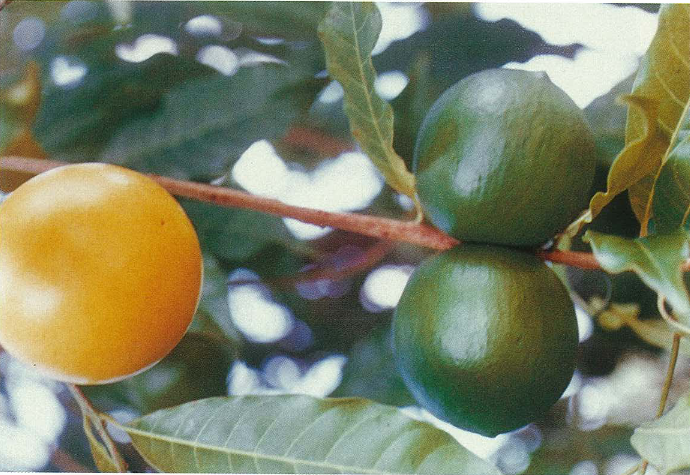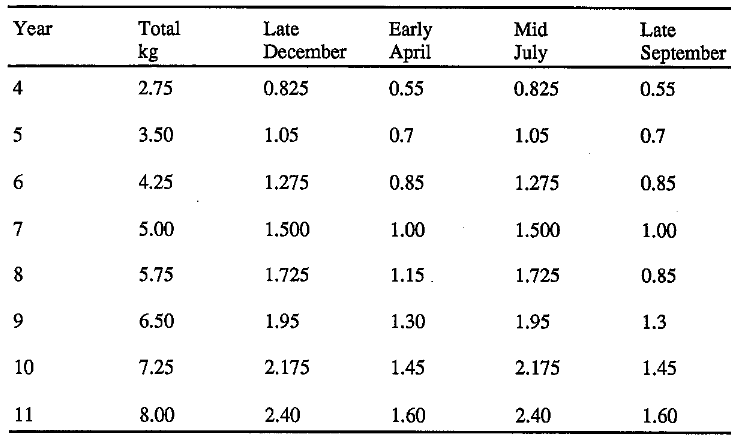Abiu is an attractive, bright yellow fruit with a sweet, caramel flavoured, creamy-white pulp. It is produced on a small tree which grows well and flowers and fruits prolifically in north Queensland and around Darwin. The fruit is available 8 months of the year in Australia and has a good potential for commercial development. Abiu originates from the Amazon basin in South America where it may have been cultivated for some thousands of years by the Indians of the region. However, only in very recent years has it been ‘discovered’ and grown commercially outside its home range. It is grown to a limited extent in Florida, USA, in northern Australia and two years ago in Malaysia. A grower group in Malaysia introduced two cultivars from north Queensland and has successfully grown and marketed the fruit in Malaysia, Singapore and Hong Kong. The fruit was renamed “Wong Kum Kuo” which means Emperor’s Golden Fruit and it was very well received by consumers in the region.
THE TREE
Abiu is an evergreen tree, reaching heights of five to fifteen metres in its natural habitat. The commercial varieties are usually less than 7 m high. It has alternate, longish, leathery leaves with a short stalk, arranged spirally on the branch. The flowers are small and white and appear singly or in clusters at the axil of the leaf or leaf scar, and a branch may have up to 280 flowers. They open in the morning. They are usually cross pollinated by insects. In Queensland flowering occurs three times a year and may overlap with fruit set, but in the Northern Territory two flowerings are usual, in February-March and July-August. Abiu does not appear to need a dry period to trigger flowering.
THE FRUIT

In the Northern Territory fruiting occurs from June to August and late October to January. Abiu fruit is a berry, with a smooth, leathery skin, 3-5 mm thick, containing an irritant latex when the fruit is green. When mature the fruit turns bright yellow. It varies in shape from ellipsoidal to spherical and may have a pointed end (nipple). It is 60-100 mm in diameter and weighs 100-600gm, with some fruit reaching 1 500 gm. A yield of 10-30 kg/tree/year may be obtained from three year old trees and up to 200 kg/tree/year from older trees. At spacings of 200 trees/ha (10 m by 5 m ) yields of up to 40 tons/ha /year can be obtained.
The flesh is soft, gelatinous, translucent-white and each fruit has 1-4 large dark brown seeds. Abiu is eaten slightly chilled by halving the fruit and scooping out the flesh or by cutting the fruit into segments and eating alone or in a fruit salad. It can also be used for juice and in ice-cream. The fruit is rich in vitamins and minerals: thiamine 0.2 mg, riboflavin 0.2 mg, niacin 3.4 mg, vitamin C 49 mg, calcium 22 mg and iron 1.8 mg.
CULTIVARS
Several varieties have been developed in Queensland :- Inca Gold, Cape Oasis, Gray, Z1, Z2, Z3 and Z4. Two more selections, T25 and T31, have been developed in the Territory.
To date the best cultivars are:
- Z4 – a large, round fruit cultivar with a single seed, and
- Z2 a large, ellipsoid fruit with 1-2 seed.
- Gray performs poorly around Darwin and the fruit of Z3 is small.
The characteristics of a good cultivar are:
- early, regular bearing at about 40 t/ha/ year;
- round or rotund fruits;
- a small nipple or no nipple (for ease of packing);
- mean fruit weight above 200 gm;
- absence of ‘water-soaked’ areas on the skin (see diseases);
- absence of ‘browning’ of the flesh – (see diseases);
- little skin latex;
- skin thicker than 4 mm – to protect against bruising;
- flesh firm and translucent but not glassy;
- sweet (brix 13-18%);
- seedless or with 1-2 small seeds;
- shelf life of at least 10-12 days.
AGRONOMY
Location
Abiu likes full sun and thrives best in a humid tropical environment with a year round rainfall of 1 000-3 000 mm but it is frost tolerant to 2°C and quite drought tolerant if protected from cold or dry winds by a windbreak. It can be grown on a range of soils and tolerates a wide ranges of pH (optimum 5.5-7.0) but is killed by saline soil. Irrigation is needed in the Top End to sustain good growth and fruiting.
Germination
Seeds germinate readily in 2-10 days and may germinate in the fruit but seed viability lasts only 1-2 days in dry conditions so they are difficult to store. Seeds are germinated in pots or polybags. Vegetative propagation is by top wedge grafting and budding.
Planting
Seedlings are planted out when about 9 months old and 30-40 cm high, and planting is done just before the wet season. Local investigation suggests a planting distance of 4-6 m in rows 8-10 metres apart. As the fruit is attractive to birds, planting at a closer density of 5 m by 8-10 m under netting is recommended. The planting hole should contain 200 g single superphosphate, 200 g dolomite and 2-3 kg of well cured animal manure.
Pruning
Trees should be lightly pruned when young to remove the central leader and promote well spaced branches. They should be held to 3 m in height to facilitate harvesting and branches should be not lower than 1 m from the ground.
Fertilisation
For a tree of pre-bearing age a fertiliser containing N:P:K in the ratio 10:4:8 is applied in 4-6 applications commencing 3 months after planting out: The amounts are:
- Year 1 0.5 kg
- Year 2 1.25 kg
- Year 3 2.00 kg
For a tree of bearing age the fertiliser is changed to N:P:K in the ratio of 11:8:12. It is applied as follows:
Year Total kg Late December Early April Mid July Late September
| Year | Total kg | Late December | Early April | Mid July | Late September |
| 4 | 2.75 | 0.825 | 0.55 | 0.825 | 0.55 |
| 5 | 3.50 | 1.05 | 0.7 | 1.05 | 0.7 |
| 6 | 4.25 | 1.275 | 0.85 | 1.275 | 0.85 |
| 7 | 5.00 | 1.500 | 1.00 | 1.500 | 1.00 |
| 8 | 5.75 | 1.725 | 1.15 | 1.725 | 0.85 |
| 9 | 6.50 | 1.95 | 1.30 | 1.95 | 1.3 |
| 10 | 7.25 | 2.175 | 1.45 | 2.175 | 1.45 |
| 11 | 8.00 | 2.40 | 1.60 | 2.40 | 1.60 |

The schedule should be modified accordingly following annual leaf tissue analysis and biennial soil analysis. Mean nutrient levels in Abiu leaf tissues that can be used as a guide are: N- 1.9 %, P – 0.26%, K – 0.9 %, Ca – 0.6 %, Mg – 0.5 %, Cl – 0.06%, S – 0.2 % and Zn – 16 ppm (mg/kg), Fe – 55 ppm, B – 56 ppm, Mn – 61 ppm, Cu – 5 ppm
Zinc, iron and boron deficiencies are common in abiu grown on soils around Darwin. These can be ameliorated by separate soil or foliar application of compounds containing the respective nutrient. Two or three applications per year during the flushing periods are recommended. Zinc deficiency is rectified by foliar sprays of zinc sulphate heptahydrate or a zinc chelate at the rate of 1-2 g/L. Zinc sulphate monohydrate is used if soil application is desired and the rate recommended is 10g per metre ground surface per tree. Iron deficiency is corrected by soil treatment or preferably foliar applications of iron sulphate or chelate at 1 g/L. Boron deficiency can be remedied by borax (2 g/L) or the more soluble solubor (1 g/L) by foliar sprays. For soil application, 2.5-3.5 g of borax per square metre is spread evenly over the soil. Soil pH should be above 5.5 preferably between 6-6.5 and can be maintained by liming the soil annually with lime, dolomite or gypsum.
Harvesting and Handling
The fruit is harvested when almost the whole fruit turns bright yellow and becomes fully ripe in 1-3 days at room temperature. Harvested fruit must be protected from the sun and has a shelf life of 7-14 days at 10°C. Fruit may be tray packed in shredded paper or in socks to prevent bruising.
DISEASES AND PESTS
Abiu is relatively disease free apart from sooty mould (fungi) associated with the secretions of scale insects and mealy bugs. The foliage is prone to infestation by thrips, mealy bugs, pink wax scale and green scale. Fruit is susceptible to the fruit spotting bug (Hemiptera), fruit fly and thrips. Thrips may damage young foliage and cause russet scarring of fruit. Flowers may be damaged by webbing Tortricid caterpillars.
The Hemiptera bug attacks young, green fruit to cause depressed black spots which lead to splitting as the fruit develops. Thrips and Hemiptera bugs may be controlled by sprays of endosulfan and dimethoate. Bird damage may be severe and could be a major limitation to the viability of the crop. Netting of trees is strongly recommended. A condition of browning of the flesh which shows on the fruit surface as a soft, ‘water-soaked’ area could be related to polyphenol oxidase enzymes. This needs more research and could be eliminated by genetic selection.
Reference: T.K.Lim 1991, Abiu: A Botanical and Agronomic Review,